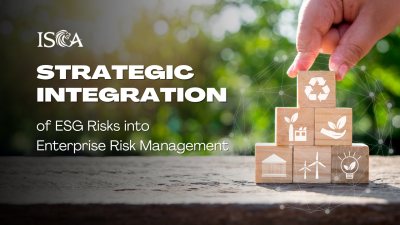
By continuing to use the ISCA Academy website, you agree to the use of cookies in accordance with our cookie policy. Cookie policy
Strategic Integration of ESG Risks into Enterprise Risk Management
English
Last updated
Tue, 04-Mar-2025
Course Description
This course draws extensively from COSO ESG risk guidance that was developed between COSO and WBCSD. Metis was commissioned to convert this guidance into training materials, subsequently delivering workshops for WBCSD members on embedding ESG in enterprise risk management (ERM).
The course will cover methods for
identifying and assessing ESG risks, including climate change, social issues,
and governance challenges. Additionally, we will share case studies of
organizations that have faced significant ESG-related risks, detailing how they
were managed and the outcomes. This course is also timely, with ESG risk rising
on corporate agendas due to the detailed risk requirements of IFRS S1, S2 and
how S3 is developing.
Directors will learn the practical
approaches to integrate ESG risks into strategic decision-making and risk
management processes, ensuring that the organization is better prepared to
manage and capitalize on ESG-related opportunities and challenges and enhancing
organizational resilience.
Objectives
•
Understand the significance of integrating ESG risks into enterprise risk
management according to COSO ESG risk guidance.
•
Evaluate the financial and operational impacts of ESG risks and compliance
requirements.
•
Oversee and guide the integration of ESG risks into the organization's
ERM framework.
•
Develop strategic insights and recommendations for aligning ESG
considerations with corporate governance and strategy.
Course outline
I.
Understanding ESG Risks
a. Overview of ESG risks and their relevance to corporate
strategy
b.
How to integrate ESG into enterprise risk management
c.
Ensuring alignment between ESG considerations and corporate strategy
d.
The business cases for managing ESG risk
II. Metrics,
Target and Performance
a.
Relevant ESG metrics and alignment with strategy
b.
Embedding ESG into performance measurement
c.
Key features of ESG assurance and the assurance process
d.
Types of ESG assurance and key developments
III. Governance
and Oversight
a.
Regulatory changes and responsibilities on ESG
b. Role of the board in overseeing ESG risk
integration

Dr Robert Charnock
Course Rating
Speaker's Rating

1 CPE Hour

Lesson
4
You have not enrolled to the BOD Programme!
Please click to sign up.
You have not subscribed to the BOD Library!
Please click to subscribe.

Succeed and lead with confidence as a board member. Empower yourself with up-to-date directorship training.
